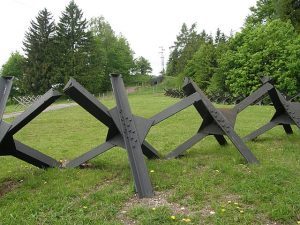Women at the Siege of Leningrad
[WARNING: For the next few weeks, it’s going to be all women warriors (and occasionally Women Warriors) all the time here at the Margins as we lead up to my publication date of February 26. I’ll try to keep the My Book! My Book! to a minimum and focus on the stories instead, but I may slip now and then because I’m excited.]
 The siege of Leningrad is generally considered the worst siege in history: 872 days of blockade and bombing that killed between 1.6 and 2 million Soviet citizens . (1) Women bore the brunt of the siege, thanks to the military draft and Stalin’s purges, which claimed more men than women. Over the course of the siege, the shortage of men grew worse, as the call for soldiers continued.
The siege of Leningrad is generally considered the worst siege in history: 872 days of blockade and bombing that killed between 1.6 and 2 million Soviet citizens . (1) Women bore the brunt of the siege, thanks to the military draft and Stalin’s purges, which claimed more men than women. Over the course of the siege, the shortage of men grew worse, as the call for soldiers continued.
Russia was unprepared for the German attack. Stalin refused to believe it would happen, even after he received a personal warning from the German ambassador in Moscow. (Can you say hubris, boys and girls?)Russian media dismissed rumors that German divisions were deploying along the Russian border as propaganda.
When the invasion came, it was swift and ruthless. Germany’s Operation Barbarossa was a three-pronged attack of three million troops with 7,000 guns and 3,300 tanks along a two-thousand-mile front. Leningrad (now St. Petersburg) was the primary target for Army Group North, led by Field Marshal Wilhelm Ritter von Leeb. Leeb’s instructions were to take the city by July 21, reduce it to rubble, slaughter its inhabitants, and then turn his attention to Moscow. Hitler was so sure of victory that he sent out invitations to celebrate Christmas 1941 in Leningrad. (Can you say hubris, again?)
While the Germans advanced, the people of Leningrad worked to construct concentric defense lines around their otherwise defenseless city. Half a million Leningraders, mostly women (2), were drafted to build fortifications first on the Pskov-Ostrov and Luga River defense lines, 180 and 60 miles southwest of Leningrad respectively, and later in Leningrad itself. Between June 22 and August 20, civilian laborers built 620 miles of earthworks. They dug 420 miles of antitank ditches and thousands of miles of defensive trenches. They strung 320 miles of barbed wire across the approaches to the city, constructed the static antitank devices known as “Czech hedgehogs,” and built some five thousand earth, timber, and concrete pillboxes—small defensive structures built with peepholes through which a weapon could be fired. It was heavy manual labor performed without the benefit of mechanized construction equipment. Women dug trenches by hand and worked together to carry heavy timber and stones. Driven by reports of the rapid German advance, they worked long days in primitive conditions, with no shelter against the enemy aircraft that strafed their construction sites.
By September the city was under siege. That month alone, the Germans launched two hundred artillery bombardments and twenty-three major air raids against Leningrad, but were unable to break through the city’s defenses.
In addition to regular Red Army units, the city was defended by “destruction battalions,” which had originally been created to deal with internal security threats, and by nine divisions of the narodne opolchenie, a volunteer citizen’s militia organized by the Communist Party.(3) By late August, when the Germans had almost encircled the city, the military command officially encouraged women and teenage boys to enlist: about a quarter of the eligible volunteers were women.
Unlike most home guards in World War II, the opolchenie fought. They had little training. Armed with a variety of small arms and hundreds of thousands of bottles of flammable liquid, dubbed “Molotov cocktails” by the Finnish soldiers, their primary task was to stop the advance of German armored divisions by hurling grenades and gasoline bombs at German tanks from slit trenches. A. A. Gusev, a political commissar in the second opolchenie, summed up the experience: “Our people are poorly trained and insufficiently armed. We fight more from the soul and heart than from military training.”
The only real advantage the city’s defenders had was that Leningrad was one of Russia’s largest centers of manufacturing munitions. Thousands of women replaced their husbands and brothers in Leningrad’s factories, the Russian counterparts of Rosie the Riveter. Unlike Rosie, factory workers, male and female, were armed (badly) and received training at the end of their eleven-hour days as members of “worker battalions,” intended to defend the city factory-by-factory if need be.
Faced with massive bombardment and starvation—a combination of the newest and oldest techniques of siege warfare—the defenders of Leningrad held out against German troops until January 27, 1944.
Like women in sieges before them across the millennia, the women of Leningrad defended their city with courage and grim determination. Because sometimes the distance from the home front to the frontline is only a few short steps.
(1) The number is horrifying enough as it stands, but it looks even worse if you add two pieces of context:
- The Soviet Union consistently under-reported its losses. (In other words, modern battle statistics are no more reliable than battle statistics from the ancient world.)
- Estimated Soviet losses at Leningrad exceed the total number of Americans, military and civilian alike,, who have died in wars from the American Revolution through 2002.
(2) A fact that is often glossed over in standard histories of the siege but is all too clear in photographs of the period.
(3) Translated as “people’s army” in accounts of Soviet Russia, opolchenie could just as easily be translated as home guard, volunteers, militia, or territorial army. The German invasion was not the first time the opolchenie had mustered in times of war. The first reference appears in the Russo-Polish War of 1605–1618.
*******
And now for a word (or three) from our sponsor:

1. Beacon Press is giving away 20 copies of Women Warriors on Goodreads. Enter here by 2/15 to be included: https://www.goodreads.com/giveaway/show/288662
2. We’ve got swag! If you buy the book by 2/25 and want women warrior trading cards, a book mark and a signed bookplate, fill out this form and upload your receipt: www.beacon.org/warriorspreorder Just so there’s no confusion: You don’t have to buy the book (or e-book or audiobook) directly from Beacon: pre-orders from any vendor count.
3. If you want a signed copy of Women Warriors and don’t expect to see me in real life, you can order one from my local independent bookstore, The Seminary Coop . https://www.semcoop.com/women-warriors-unexpected-history Just state that you want a signed copy in the comments field.





